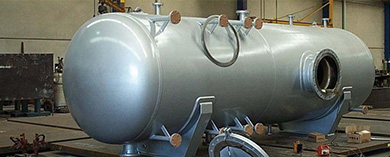
- (03) 5909 8218
- enquiry@fusionweld.com.au
Quality Storage Vessels
September 2, 2013

Pressure equipment comes with inherent dangers. The weight, the pressure and the nature of chemicals often used with it create risks that could cause financial or personnel disasters. By paying attention to four factors, these dangers can be minimized.
The first step is choosing a source of pressure equipment. Since pressure equipment is generally part of a storage, delivery or manufacturing system, having a pressure equipment vendor who is experienced is a massive head start on designing a safe system. Vendors who are experienced in the engineering can be an invaluable asset, acting the part of design consultant as much as a place to get components. Mating incompatible components or building a system with logistics problems could dramatically increase the danger associated with pressure equipment.
The next step is setting the stage for the equipment. Does it require a certain temperature to operate safely? What about a certain level of humidity? Again, a quality vendor is the best source of this information. By housing pressure equipment in the best manner possible, both the durability and safety of it is enhanced.
After the correct environment for the equipment is created, it is time for the install. For stationary pressure equipment, having enough support and clearance is crucial in the avoidance of accidents. The weight of any large piece of industrial equipment is such that a poor installation is unacceptable.
The last and most complicated safety concern is regulating the personnel who will be working with and around the equipment. A quick list of very general "do this, do not do this" type of rules can be compiled from a talk with any vendor of pressure equipment. Having that talk with a vendor who has experience in real world applications will move beyond the universal rules and help create an operation plan for a specific situation. Situational rules may result from problems that are difficult to foresee, like the noise of large deliveries masking the alert sounds of monitoring equipment. This sort of problem can be solved with either procedure, like scheduling work with the equipment when deliveries are not occurring, or through infrastructure, like building a sound buffer between the equipment and the delivery area.
Once all the pieces are in place, it is simply a matter of ensuring that they stay that way. Regular inspections of the equipment to ensure its soundness are mandatory for safety minded companies. Likewise, regular monitoring of staff to ensure that they are complying with safety regulations can prevent disaster.
Contact Details
Fusion - Weld Engineering Pty Ltd
ABN 98 068 987619
1865 Frankston Flinders Road,
Hastings, VIC 3915
Ph: (03) 5909 8218
Optimized by NetwizardSEO.com.au
Recent Posts
- Storage Tank Solutions Australia: Field-Erected, Prefabricated & Self-Bunded Explained
- Reducing Environmental Risks: Self-Bunded Tanks in Australian Oil & Gas Operations
- Precision in Production: How Pressure Vessels Are Manufactured for Industrial Safety
- Shell & Tube Heat Exchangers: Improve Thermal Control & Energy Recovery in Petrochemical & Pharmaceutical Plants
- In-Service Inspection for Compressed Air Receivers for Power Plant Shutdown Prevention
- Power Plant Pipe Spooling Fabrication – Get Rapid, Code-Compliant Spools Ready for Installation
- Field Erected Tanks: Safe, Reliable On-Site Fuel Storage Solutions in Australia
- Custom Pressure Vessel Fabrication for Flammable Gases
- Heat Exchangers for Oil & Gas Refineries - Custom-Built for Performance & Compliance
Posts 2025
- Storage Tank Solutions Australia: Field-Erected, Prefabricated & Self-Bunded Explained
- Reducing Environmental Risks: Self-Bunded Tanks in Australian Oil & Gas Operations
- View all articles…
Posts 2024
- Large Process Vessels: Optimising the Design for Maximum Efficiency [2025]
- Pressure Equipment Management System Installation: Detect Equipment Faults Early
- View all articles…
Posts 2023
- Pressure Piping System Inspection: A Gift of Safety for the Holidays
- Deaerator Inspections by Fusion-Weld Engineering and How They Reduce System Downtime
- View all articles…
Posts 2022
- How Fusion Weld Keeps Up With AS-NZS ISO 9001:2008 Standard
- Boiler Equipment Safety Inspection During the Summer Season
- View all articles…
Posts 2021
- Avoid These Factors and Practices that Contribute to Sealing Damage in Pressure Vessels
- Do's And Don'ts Of Industrial Boiler Inspection And Maintenance From Fusion-Weld
- View all articles…
Posts 2020
- What are the Risks and Hazards Involved in Pressure Vessel Equipment?
- How to Know if Your Pressure Equipment Needs Repair or Replacement?
- View all articles…
Posts 2019
- Factors that Contribute to Pressure Vessel Failure
- Pressure Vessel Regulations in Australia: What are the Mandatory Requirements?
- View all articles…
Posts 2018
- Pros and Cons of Spherical vs. Cylindrical Pressure Vessels
- What are the Different Hazard Levels in Pressure Vessels?
- View all articles…
Posts 2017
- Transportable Pressure Vessels: The Importance of Inspection and Safety Checks
- Fracture Mechanics and Stress Analysis of Cracks in Pressure Vessels
- View all articles…
Posts 2016
Posts 2015
- What Are Deaerators & Feedwater Vessels?
- Precautions and Safety for Compressed Air Receiver Vessels
- View all articles…
Posts 2014
- Demonstrating In-process Inspection Procedures
- Static Grounding Practices and Standards
- View all articles…